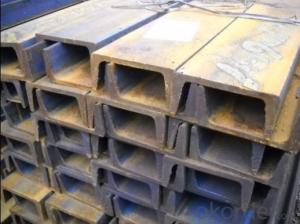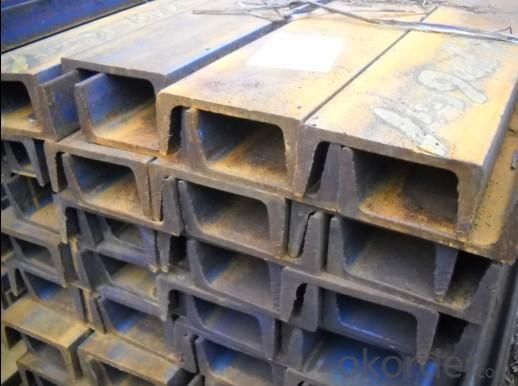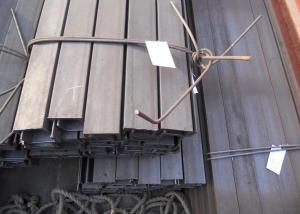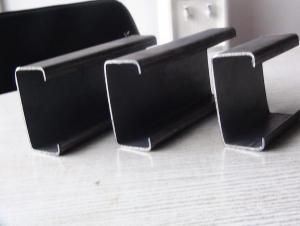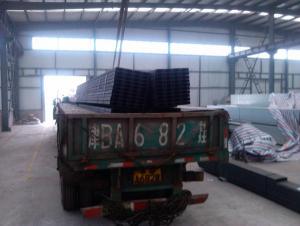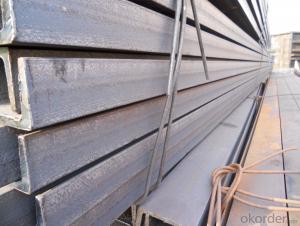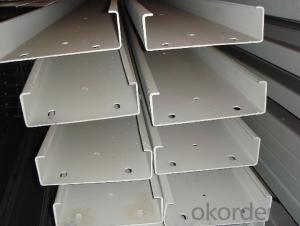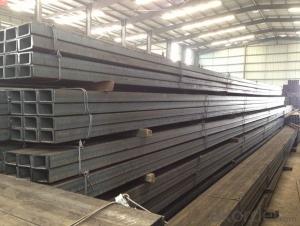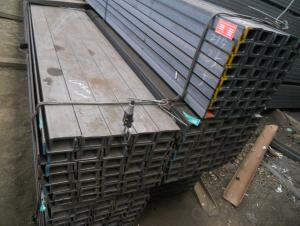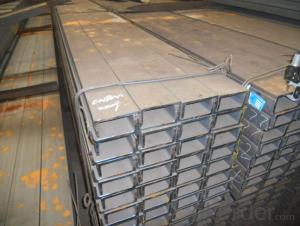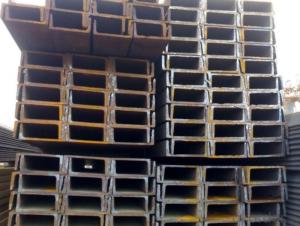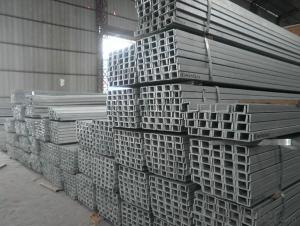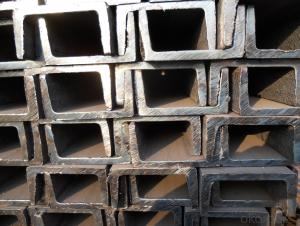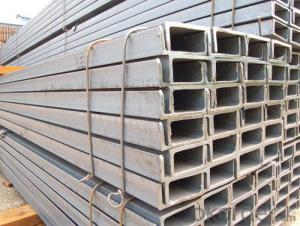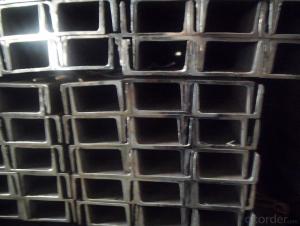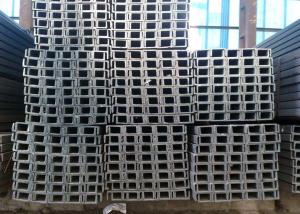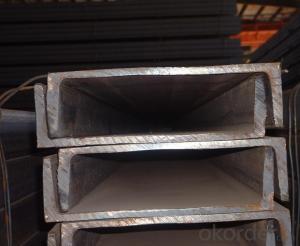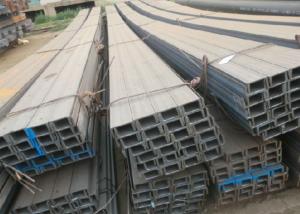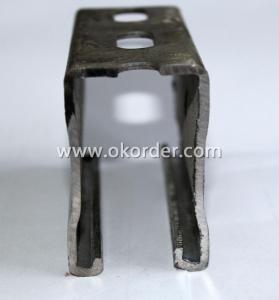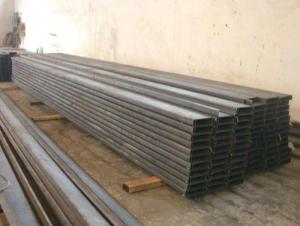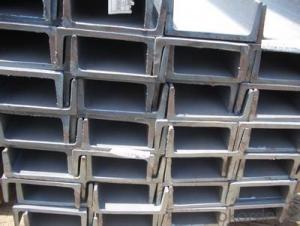100mm EN Standard U Channels for construction
- Loading Port:
- Tianjin
- Payment Terms:
- TT OR LC
- Min Order Qty:
- 25 m.t.
- Supply Capability:
- 10000 m.t./month
OKorder Service Pledge
OKorder Financial Service
You Might Also Like
Usage/Applications of Channel Steel:
Channel Steel is usually used for building structure, vehicle manufacturing and other industrial structure and often used with i beam.
In details, the channel steel belongs to carbon structural steel which is applied to in the field of construction and machinery. The channel steel is usually used for arch-itechtural structure, and they could be welded in order to support or hang a vari-ety of facilities. They are also usually used in combination with I beam. Generally,the channel steel must possess perfect welding property, riveting property and mechanical property and so on.
Package & Delivery of Channel Steel:
The steel u channel will be packed in bundle with steel wire at each end of every bundle and color marking in order to help the customer to recognize his goods more easily at sight.
And steel u channel could be loaded into 20ft or 40ft container, or by bulk cargo. If the weight of each bundle reaches less than 3.5 mt, the loading by break bulk cargo should be choosed. When the weight of each bundle reaches less than 3mt, the loading by container should be choosed.
As for the transportaion from mill to loading port, the truck will be usually used. And the maximum quantity for each truck is 40mt.
Ceiling channel and drywall channel, made of high-quality Snowflakes Steel, adopting laminose strut channel by Cold-formed Technology, are a kind of metal framework made after several continuous rolling. Ceiling keel and wall channel has light-weight, high-intensity, good-antisepsis and other advantages. They mainly match to paperbacked plasterboard and other goods, also the other plates such as GRC, FT and so on.
Product Applications:
purlin and wall beam of steel structure building
Product Advantages:
1.Light,good strength,cauterization resistance and water resistance
2.Matching magnesium fire-proof board,gypsum board and many other wall and ceiling board
3.Moisure-proof ,shock-resistant,high-effcient and environmentally-friendly
4.Easy and fast for installation,time-saving
5. Prompt delivery, high quality ,competitive price and complete sets of styles
6.We can supply you the products based on your specific requirements
Main Product Features:
1). Commponents: main tee, long cross tee, short cross tee and wall angle.
2). Unique click design for easy connection.
3). Widely usage for the suspension system of hotel, school, hospital, shopping mall, etc.
4). Nice outlook with competitive price and good quality.
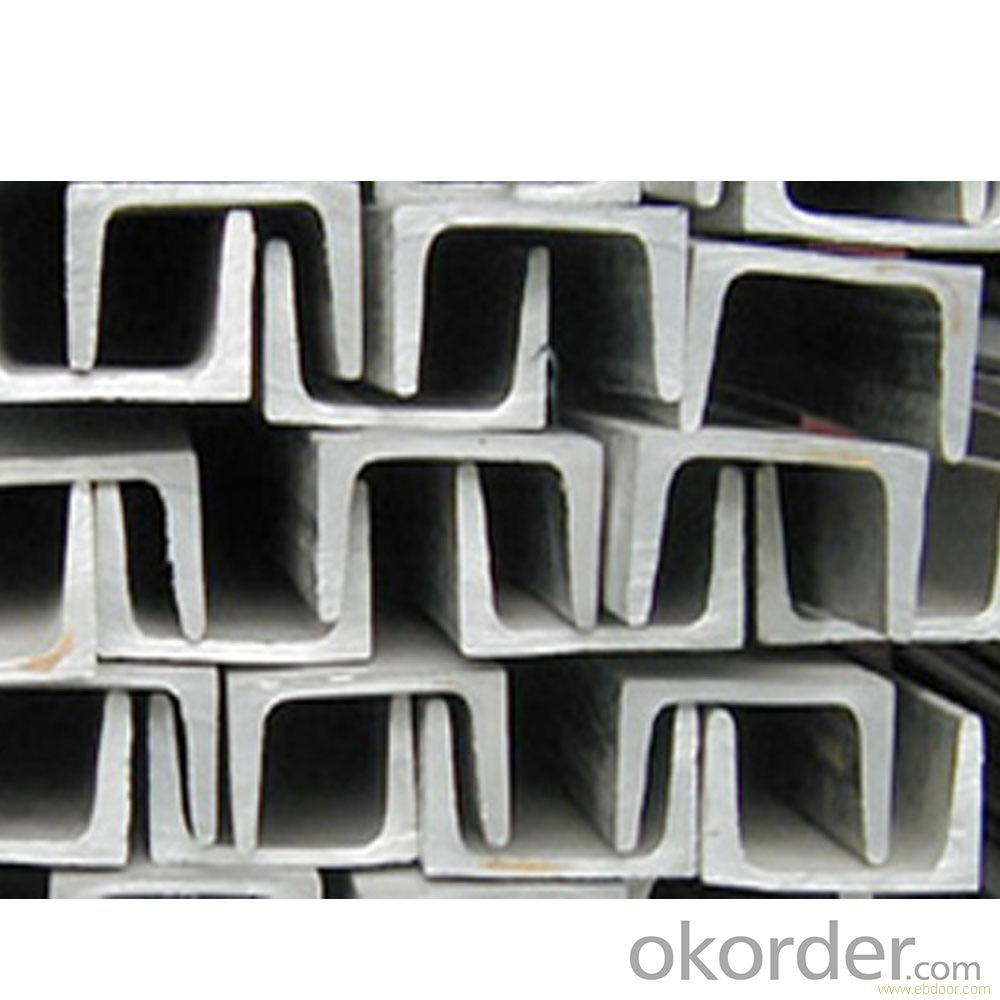
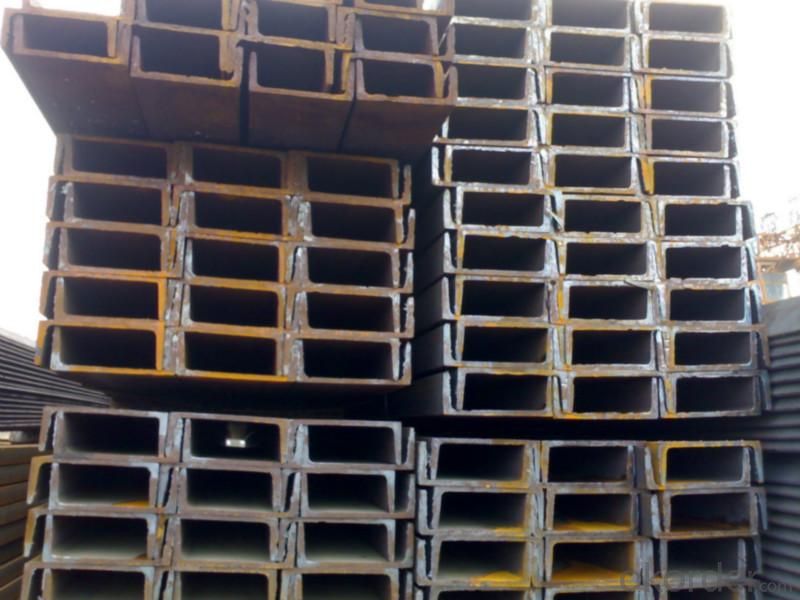
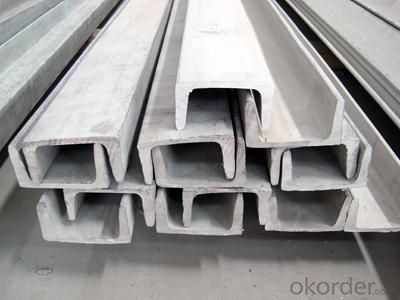
- Q: Can steel channels be used in marine environments?
- Yes, steel channels can be used in marine environments. However, it is important to choose the right type of steel and apply appropriate corrosion protection measures to ensure their longevity and performance in such conditions. Marine environments are known for their high levels of moisture, saltwater exposure, and corrosive elements, which can lead to accelerated corrosion and degradation of metals. When selecting steel channels for marine applications, materials with high corrosion resistance, such as stainless steel or galvanized steel, are recommended. Stainless steel, in particular, is highly resistant to corrosion and can withstand the harsh conditions of marine environments. Galvanized steel, on the other hand, is coated with a layer of zinc, which provides a protective barrier against corrosion. Furthermore, it is essential to implement proper maintenance and inspection practices to detect and address any signs of corrosion or damage promptly. Regular cleaning, removing any marine growth, and applying protective coatings can help extend the lifespan of steel channels in marine environments. In conclusion, while steel channels can be used in marine environments, it is crucial to select the appropriate type of steel and apply proper corrosion protection measures to ensure their durability and performance in these challenging conditions.
- Q: What are the different load distribution techniques for steel channels in floor systems?
- There are several different load distribution techniques for steel channels in floor systems. These techniques are used to effectively distribute the weight and load-bearing capacity of the floor system, ensuring its stability and structural integrity. One common load distribution technique is the use of evenly spaced steel channels throughout the floor system. These channels are typically installed perpendicular to the direction of the load, creating a grid-like pattern. This technique helps evenly distribute the weight across the entire floor system, preventing any individual channel from bearing an excessive amount of load. Another load distribution technique is the use of composite beams. In this technique, steel channels are combined with other materials, such as concrete or wood, to create a composite beam. The combination of materials helps distribute the load across a larger area, increasing the overall load-bearing capacity of the floor system. Additionally, load distribution can be achieved through the use of beam supports or joists. These supports are installed underneath the steel channels to provide additional strength and distribute the load to the surrounding areas. Beam supports can be made of steel, wood, or other materials depending on the specific requirements of the floor system. Finally, the load distribution technique can also be influenced by the design of the floor system itself. For example, the placement and spacing of the steel channels can be optimized to distribute the load more effectively. Additionally, the use of additional reinforcement, such as steel plates or braces, can further enhance the load distribution capabilities of the floor system. In summary, load distribution techniques for steel channels in floor systems include the use of evenly spaced channels, composite beams, beam supports, and optimized system design. These techniques help ensure that the weight and load-bearing capacity of the floor system is distributed effectively, resulting in a stable and structurally sound construction.
- Q: Can steel channels be painted?
- Steel channels can indeed be painted, and this painting process can offer a protective layer that prevents corrosion and enhances their visual appeal. However, there are a few vital considerations to bear in mind when painting steel channels. Firstly, it is crucial to ensure that the surface of the channels is thoroughly clean and devoid of any dirt, grease, or rust. To achieve this, it is recommended to employ a wire brush or sandpaper to eliminate any loose particles and create a smooth surface for the paint to adhere to. Furthermore, it is of utmost importance to utilize a primer specifically formulated for metal surfaces. This will ensure appropriate adhesion and durability of the paint. Once the primer has been applied and allowed to dry, a suitable paint can be selected to coat the steel channels. It is essential to choose a paint that is compatible with metal surfaces and offers resistance to corrosion and weathering. In some cases, multiple coats of paint may be necessary to achieve the desired finish and durability. Overall, by properly preparing the surface and utilizing appropriate primers and paints, steel channels can be effectively painted to both protect and enhance their appearance.
- Q: Do steel channels have any specific safety considerations?
- Indeed, specific safety considerations must be taken into account when dealing with steel channels. These channels are widely utilized in construction and industrial settings to provide structural support, but mishandling them can result in certain safety hazards. One aspect to consider is the weight and dimensions of steel channels. Due to their heaviness and unwieldiness, proper lifting techniques must be employed to prevent strain or harm to workers. Furthermore, caution should be exercised when working in proximity to or underneath steel channels to prevent potential accidents in the event of a fall or collapse. Another safety concern pertains to the sharp edges and corners of steel channels. These sharp surfaces can cause lacerations or punctures if adequate precautions are not taken. To minimize the risk of injury, workers should don appropriate protective gear, including gloves, safety glasses, and steel-toed boots. Additionally, fire safety should not be overlooked when working with steel channels. As steel is an excellent conductor of heat, steel channels can become hot during a fire incident. To minimize the spread of fire through these channels, suitable fire prevention measures and fire-resistant coatings should be implemented. Lastly, ensuring proper installation and maintenance of steel channels is crucial to uphold their structural integrity and safety. Regular inspections should be conducted to identify any signs of corrosion, damage, or fatigue. Promptly addressing any issues can prevent potential structural failures or accidents. In conclusion, although steel channels are known for their durability and widespread use, it is vital to be mindful of the specific safety considerations associated with them. By adhering to proper safety protocols, workers can mitigate risks and maintain a safe working environment.
- Q: What are the considerations for designing steel channel connections?
- When designing steel channel connections, there are several key considerations that must be taken into account to ensure the structural integrity and safety of the overall system. These considerations include: 1. Load capacity: The connection design should be able to withstand the expected loads and forces that will act on the steel channels. This includes both static and dynamic loads, such as dead loads, live loads, wind loads, and seismic loads. 2. Connection type: There are various types of connections that can be used for steel channels, such as bolted connections, welded connections, or a combination of both. The type of connection chosen should be based on factors such as the expected loads, ease of installation, maintenance requirements, and cost-effectiveness. 3. Strength and stiffness: The connection design should provide adequate strength and stiffness to resist the applied loads without excessive deflection or deformation. This involves considering the material properties of the steel channels, such as yield strength, ultimate strength, and modulus of elasticity, as well as the connection details and geometry. 4. Fatigue resistance: If the steel channels are subjected to cyclic or repeated loading, such as in bridges or machinery, the connection design should be able to resist fatigue failure. This may require incorporating features such as fillet welds, reinforcement plates, or special detailing to enhance the fatigue strength of the connection. 5. Alignment and fit-up: Proper alignment and fit-up of the steel channels at the connection points are critical for ensuring a secure and effective connection. The connection design should account for any potential misalignments or tolerances in the fabrication and erection process, and provide means for adjustment or correction if needed. 6. Serviceability and maintenance: The connection design should consider the long-term performance and durability of the connection. This includes factors such as corrosion protection, accessibility for inspection and maintenance, and the potential for future modifications or repairs. 7. Code compliance: The connection design should comply with relevant building codes, standards, and regulations. It is important to consider the requirements and guidelines specified by national or international codes, as well as any specific design criteria or recommendations from structural engineering associations. Overall, designing steel channel connections requires a thorough understanding of the mechanical behavior of steel, as well as the specific loading conditions and performance requirements. By considering these factors and utilizing appropriate design methods and principles, engineers can ensure the reliability and safety of steel channel connections in various structural applications.
- Q: How do steel channels contribute to the overall ventilation of a building?
- Steel channels are an integral part of the overall ventilation system in a building as they provide pathways for the movement of air. These channels are strategically placed throughout the structure, allowing fresh air to enter and stale air to exit. By facilitating proper airflow, steel channels help regulate temperature, remove pollutants, and improve air quality, thereby contributing to a healthier and more comfortable environment inside the building.
- Q: Are steel channels recyclable?
- Yes, steel channels are recyclable. Steel is one of the most recycled materials in the world, and steel channels can be melted down and reused to create new steel products.
- Q: What are the different methods for protecting steel channels from UV radiation?
- There are several methods for protecting steel channels from UV radiation. One common approach is to apply a protective coating or paint that contains UV inhibitors. This helps to block or absorb the harmful UV rays and prevent them from damaging the steel. Another method is to use a UV-resistant film or wrap, which can be applied directly to the surface of the steel channel. This film acts as a barrier, shielding the steel from the UV rays. Additionally, using materials with inherent UV resistance, such as stainless steel or aluminum, can provide natural protection against UV radiation. It is important to regularly inspect and maintain these protective measures to ensure their effectiveness over time.
- Q: Can steel channels be used in power plant construction?
- Indeed, power plant construction can make effective use of steel channels. Given their robustness, longevity, and adaptability, steel channels find frequent application in structural and construction contexts. Within power plant construction, steel channels serve various functions, including the provision of support for heavy machinery, the formation of structural frameworks, and the reinforcement of concrete structures. Notably, these channels exhibit exceptional load-bearing capacity, contributing to the overall stability and support of the power plant's structure. Furthermore, steel channels can be readily fabricated and tailored to meet specific project needs, rendering them a fitting option for power plant construction.
- Q: Can steel channels be used for support columns?
- Yes, steel channels can be used for support columns. Steel channels are commonly used in construction for various structural applications, including supporting columns. They are known for their strength and durability, making them ideal for bearing heavy loads and providing structural support. Additionally, steel channels can be easily fabricated and installed, making them a popular choice for support columns in both commercial and residential buildings.
Send your message to us
100mm EN Standard U Channels for construction
- Loading Port:
- Tianjin
- Payment Terms:
- TT OR LC
- Min Order Qty:
- 25 m.t.
- Supply Capability:
- 10000 m.t./month
OKorder Service Pledge
OKorder Financial Service
Similar products
Hot products
Hot Searches
Related keywords
